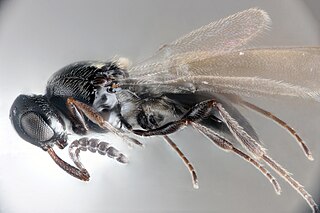Related Research Articles
Anteris is a genus of wasps in the family Platygastridae. There are about 15 described species in Anteris.

Telenominae is a subfamily of parasitoid wasps in the family Scelionidae. It was previously considered a subfamily of Platygastridae.

Eulophinae is a subfamily of wasps in the family Eulophidae which includes over 90 genera.

Teleasinae is a subfamily of parasitoid wasps in the family Scelionidae. It was previously considered a subfamily of Platygastridae.

Trissolcus is a genus of parasitoid wasps in the family Scelionidae. There are at least 180 described species in Trissolcus. They parasitize eggs of Pentatomomorpha.
Metaclisis is a genus of parasitoid wasps in the family Platygastridae. There are at least 30 described species in Metaclisis.

Trichacis is a genus of parasitoid wasps in the family Platygastridae. Members of this genus have a tuft of setae on the mesoscutellum and transverse striae or rugulae above the antennae. They are parasitoids of Cecidomyiidae, although the hosts of most species remain unknown.
A list of the species of Hymenoptera from New Zealand; which includes ants, bees, parasitoids, sawflies, and social wasps.

Idris is a genus of parasitic wasps in the family Platygastridae, containing about 160 described species. This genus is part of the tribe Baeini, which are egg parasitoids. Members of the genus Idris are mostly parasitoids of spider eggs, but at least one member of the genus uses stink bugs as hosts.
Amblyaspis is a genus of parasitoid wasps belonging to the family Platygastridae.
Isocybus is a genus of parasitoid wasps belonging to the family Platygastridae.
Leptacis is a genus of parasitoid wasps belonging to the family Platygastridae.
Allotropa is a genus of parasitoid wasp in the family Platygastridae. The genus has an almost cosmopolitan distribution.
Aphanogmus is a genus of wasps in the family Ceraphronidae that was erected by Carl Gustaf Thomson in 1858. Belgian entomologist Paul Dessart worked on the genus in the 1970's.
References
- ↑ "Synopeas Report". Integrated Taxonomic Information System. Retrieved 2019-04-18.
- ↑ "Synopeas". GBIF. Retrieved 2019-04-18.
- ↑ "Synopeas Genus Information". BugGuide.net. Retrieved 2019-04-18.
- ↑ Jessica Awad; Jonathan S. Bremer; Philip T. Butterill; Matthew R. Moore; Elijah J. Talamas (23 December 2021). "A taxonomic treatment of Synopeas Förster (Platygastridae, Platygastrinae) from the island of New Guinea". Journal of Hymenoptera Research . 87: 5–65. doi: 10.3897/JHR.87.65563 . ISSN 1070-9428. Wikidata Q110290989.
- ↑ Asadi-Farfar, Maryam; Karimpour, Younes; Lotfalizadeh, Hossein; Buhl, Peter Neerup (2021-05-14). "Four new species and new records of Platygastrinae (Hymenoptera: Platygastridae) from Iran". European Journal of Taxonomy (750). Museum National D'Histoire Naturelle: 29–51. doi:10.5852/ejt.2021.750.1359. ISSN 2118-9773.
- ↑ Melotto, Gloria; Awad, Jessica; Talamas, Elijah J.; Koch, Robert L.; Lindsey, Amelia R. I. (2023-05-02). "Synopeas maximum Awad & Talamas (Hymenoptera, Platygastridae): a new species of parasitoid associated with soybean gall midge, Resseliella maxima Gagné (Diptera, Cecidomyiidae)". Journal of Hymenoptera Research. 96. Pensoft Publishers: 181–205. doi: 10.3897/jhr.96.102865 . ISSN 1314-2607.